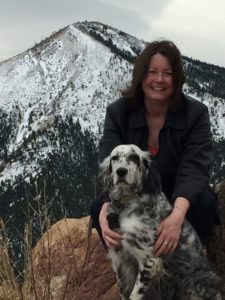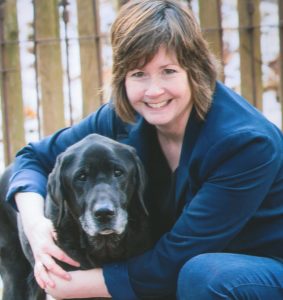Diane Brown, B.S., ’83; D.V.M., ’86; Ph.D., ‘95

Dr. Diane Brown has worked as a general practitioner, as a researcher in the pharmaceutical industry, as a primary investigator at Harvard University, and as a leader in the non-profit world. Now, as the chief executive officer at the American Kennel Club Canine Health Foundation, she draws upon all of those experiences daily to improve the health of dogs. I spoke to Dr. Brown from her office in Raleigh, North Carolina, as she reflected on her early love of animals, her pioneering career moves, and how she values collaboration as a tool for change.
Animal upbringing
“My interest in veterinary medicine came about as early as I can remember. My earliest memories are all about animals. My family was outdoorsy and that allowed me to care for everything from little rodents to fish to dogs to wildlife – really a multi-species household! My fate was sealed when I got my first puppy in fifth grade. I remember taking that puppy into the veterinary clinic for the first time, and the exam room just felt like a home space to me.”
My Ram fam
“Being a CSU Ram is truly a family affair. My dad graduated from CSU when it was Colorado A&M. My oldest brother earned his Ph.D. in Fishery Biology. My middle brother has an undergraduate degree in Agricultural Sciences and my youngest brother, a B.A. in History and a Master’s in Education. For me, I was always going to go to veterinary school. And it just so happened that one of the best veterinary schools in the country was in the same town in which I grew up.”
A “state of support”
“During my undergraduate years, I was surprised and excited by the number of people I met from across the country. I developed friends that became life-long during my freshman year. It was remarkable to meet so many different people with big dreams in so many different fields that came to CSU.
“I also received wonderful mentorship at CSU, especially one-on-one with faculty members. Additionally, I worked for a small animal veterinarian in Fort Collins, Dr. Charles Buchan, throughout my high school, undergraduate and D.V.M. years. I was also fortunate to have two accomplished researchers in the family, my dad and my oldest brother Dave, both of whom influenced me greatly. Mentorship was key to my career choices and gaining confidence in my decisions.

“As a veterinary student, I was certain that I would be a general practitioner. By the time I was a senior, I had developed special interests in ophthalmology and clinical pathology. I decided to forego the internship match program, instead entering a high-quality and high-volume practice with eyes on a possible future residency.
“After four years of practice, my interest in clinical pathology had grown, and I wanted to complete a clinical pathology residency because pathology had shaped so many of the cases I saw as a general practitioner. It was where I needed to know more. I was especially interested in hematology and bone marrow transplantation, and the two veterinary schools that were doing such work at the time were the University of Pennsylvania and CSU. Given the strength of the CSU clinical pathology faculty, residency and research programs, I certainly was not going to give up the opportunity to return to Fort Collins.
“It was a wonderful time to be back at CSU. The pathology program was robust, on both the clinical and the research sides. Dr. Mary Anna Thrall was my major advisor, leading a laboratory with long-term NIH funding, and Dr. Glade Weiser was my department chair. Their expertise, mentoring and advice advanced my learning then, and throughout the course of my career. My fellow residents – people like Gregg Dean, Jamie Young, Mary Jo Burkhard, Jaime Modiano, and E.J. Ehrhart – have gone on to shape the fields of pathology and animal cancer research in really significant ways.
From resident to researcher
“As I was finishing my Ph.D. and residency, as well as preparing for pathology boards, I was also trying to decide what I was going to do with my career. I was looking for a top-notch experience next, but did not have the financial means to take a post-doctoral position in a major metropolitan area and still support my family. During my doctoral program, I had great experiences working with researchers in human medical institutions like Albert Einstein College of Medicine in New York City and Thomas Jefferson University in Philadelphia. Those experiences gave me the confidence to think beyond veterinary medicine and to accept an opportunity in the pharmaceutical industry. This was really a leap of faith because there were very few of my colleagues or mentors at the time that could give me insight on what a position like this might fully entail.
“The industry position came with big investigative groups and lots of funding – things that allowed my career to take shape quickly. I was part of the early lead optimization program for a warfarin alternative (a very popular pharmaceutical in human medicine). I also was leading a laboratory within a biotechnology collaboration to do some of the early gene phenotyping work to map the human genome. Although it was a world away from my academic roots, I maintained affiliate faculty appointments with schools of veterinary medicine, continued to teach, and learned the value of academic-industry collaboration. I have drawn upon those skills many times in other roles.
One Health before One Health was cool
“Returning to a full-time academic appointment was driven by opportunity. My son was graduating from high school and I was able to relocate and make a career transition. Being able to join the faculty of Harvard Medical School and set up a lab at Massachusetts General Hospital was a phenomenal experience. These high-quality medical/research institutions drive progress through excellence, and through the mindset and compassion of each person who works there.
“I did get some early prejudice for being a D.V.M., not an M.D., and really needed my Ph.D. – both in name and experience – to succeed at Harvard. I would pick up my nametag at workshops or conferences at the hospital/medical school and it would say “Diane Brown, Ph.D.” as if my D.V.M. degree was forgotten. I think this was out of ignorance, not out of disrespect, and it gave me another opportunity for educational outreach. I give a lot of credit to my department head for having had the foresight to hire me. There is great value in comparative pathology and comparative medicine, and I was proud to bring my veterinary background to Harvard/Mass General Hospital.
A woman in the C-suite
“I loved Harvard/Mass General Hospital and thought I would spend the rest of my career there. When I was offered an incredible opportunity to join Morris Animal Foundation as their chief science officer, I’m not sure there would have been anything else that would have drawn me away from Harvard. My interest in the non-profit world was two-fold. First, it was a position that had potential for a very broad impact, with the opportunity to influence the direction of research funding, so critical to advancing the science of veterinary medicine.

“The other was rooted in not seeing women in science and veterinary medicine realize equal representation in leadership roles. My veterinary class was the last at CSU that was more men than women, and yet I wasn’t seeing my female colleagues achieve the leadership opportunities to match the profession’s changing enrollment numbers. I have been the only woman in the room many, many times over the course of my career. This was a chance to take an executive level position not only as a woman, but as a scientist. I felt the responsibility to be a mentor and a role model.”
Shaping the future of canine health
“Now as the chief executive officer at the American Kennel Club Canine Health Foundation (CHF), I have a chance to implement a vision for the foundation. All of my professional and life experiences have aligned to allow me to put together a strategy that supports our mission at CHF. Being able to bring program ideas together, resource them, and watch them unfold has been a worthwhile experience.
“I have a wonderful team around me, from our board members and staff to our researchers and stakeholders who care deeply about canine health. All together, we look out over the broad landscape and see where we can make a difference. And that only happens because we collaborate with those in and out of our own disciplines.
“As an example, I am especially proud of the foundation’s epilepsy research initiative. Epilepsy is the top neurologic concern across all dogs, mixed breed and purebred. We have succeeded in fundraising and providing grants for researchers working to understand and treat epilepsy, achieving tangible results within a one-year time frame.
“The research has already resulted in published studies in high quality journals such as the Proceedings of the National Academy of Sciences and identified new genes that impact epilepsy in dogs and humans – One Health in action. There is also a new treatment for seizuring dogs in emergency room situations, and the foundation is investing in alternative approaches to this all-too-common and devastating disease including clinical trials in neurostimulation, cannabidiol products, and nutritional interventions. This work can continue long-term because we have built an area of excellence and collaboration at CHF for tackling epilepsy.
Work + wellness

“Wellness is an important aspect of a veterinarian’s career. I have been fortunate in my life to have had the support of family, colleagues and friends, and a child who was always flexible and joyful on this journey with me. When I started my residency, my son Kyle was just eight months old. We took on challenges and looked to the future together, relocating several times for my career, which provided us new experiences and growth opportunities at every turn. He was an integral part of everything I was always doing. I did not make career moves at the cost of everything else; I did it as part of a family team.
“Also, I can never underestimate the value of the animals in my life, learning from them at every step, and knowing they are why I do this work.”
Advice: You always can
“My advice to students is to pursue your interests. Don’t let people tell you that you can’t. You always can. Seek people out who have different experiences than your own. Even if you feel intimidated, you have to go and talk to the people you admire. Open your horizons and see a broader landscape.
“Our veterinary educations teach us to take a holistic view of the animal, the patient, and that approach can be applied to work and life. I never would have predicted the course of my career or being where I am today; my education provided me these opportunities. If you stand up with pride in your veterinary degree, and take those opportunities, you will find a place that you can make a difference.”